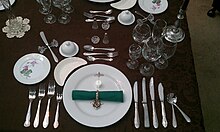Cutlery


Cutlery (also referred to as silverware, flatware, or tableware) includes any hand implement used in preparing, serving, and especially eating food in Western culture. A person who makes or sells cutlery is called a cutler. The city of Sheffield in England has been famous for the production of cutlery since the 17th century and a train – the Master Cutler – running from Sheffield to London was named after the industry.[1] Bringing affordable cutlery to the masses, stainless steel was developed in Sheffield in the early 20th century.[2]
The major items of cutlery in
Etymology
The word cutler derives from the Middle English word 'cuteler' and this in turn derives from Old French 'coutelier' which comes from 'coutel'; meaning knife (modern French: couteau).[4] The word's early origins can be seen in the Latin word 'culter' (knife).
Composition

Metallic
Sterling silver is the traditional material from which good quality cutlery is made. Historically, silver had the advantage over other metals of being less chemically reactive. Chemical reactions between certain foods and the cutlery metal can lead to unpleasant tastes. Gold is even less reactive than silver, but the use of gold cutlery was confined to the exceptionally wealthy, such as monarchs.[5]
In 1913, the British metallurgist Harry Brearley discovered stainless steel by chance, bringing affordable cutlery to the masses.[2] This metal has come to be the predominant one used in cutlery. An alternative is melchior, corrosion-resistant nickel and copper alloy, which can also sometimes contain manganese and nickel-iron.
Titanium has also been used to make cutlery for its lower thermal conductivity and weight savings compared to steel, with uses in camping.
Plastic
Wooden

Edible
Edible cutlery is made from dried grains.[6] These are made primarily with rice, millets or wheat. Since rice cultivation needs a lot of water, manufacturers market millet based products as more environment friendly. The batter is baked in moulds which hardens it. Some manufacturers offer an option of flavoured cutlery. Edible cutlery decomposes in about a week if disposed.
Industry

At Sheffield the trade of cutler became divided, with allied trades such as razormaker, awl bladesmith, shearsmith and forkmaker emerging and becoming distinct trades by the 18th century.
Before the mid 19th century when cheap mild steel became available due to new methods of steelmaking, knives (and other edged tools) were made by welding a strip of steel on to the piece of iron that was to be formed into a knife, or sandwiching a strip of steel between two pieces of iron. This was done because steel was then a much more expensive commodity than iron. Modern blades are sometimes laminated, but for a different reason. Since the hardest steel is brittle, a layer of hard steel may be laid between two layers of a milder, less brittle steel, for a blade that keeps a sharp edge well, and is less likely to break in service.
After fabrication, the knife had to be sharpened, originally on a grindstone, but from the late medieval period in a blade mill or (as they were known in the Sheffield region) a cutlers wheel.
Disposable cutlery
Plastic

Introduced for
Wooden
As an ecofriendly alternative to non-degradable plastic, wooden cutlery is gaining popularity. Some manufacturers coat their products in food-safe plant oils, waxes and lemon juice for a longer shelf life making these safe for human consumption. Cutlery is then cured for a few days before leaving the manufacturing plant.[15]
Manufacturing centres
Traditional centres of cutlery-making include:
- Caldas das Taipas in Portugal
- Albacete in Spain
- United States of America
- Premana in Italy
- Sheffield in the United Kingdom
- Solingen in Germany
- Seki and Sakai in Japan
- Styria in Austria
- Thiers and Laguiole in France
- Toledo in Spain
- Wazirabad in Pakistan
- Galway in Ireland
- Carlos Barbosa in Brazil
See also
- Cutler (disambiguation)
- Eating utensil etiquette
- Steak knife
- Table setting
- Tableware
- List of eating utensils
- List of food preparation utensils
- Sujeo
References
- ^ British Pathé. "The Master Cutler". britishpathe.com.
- ^ a b "Made in Great Britain, Series 1, Steel". BBC. Retrieved 28 March 2019.
- ISBN 978-0276445699.
- ISBN 1-874718-11-3
- ^ Miodownik, Mark (29 April 2015). "Stainless steel revolutionised eating after centuries of a bad taste in the mouth". The Guardian.
- ^ "Edible Cutlery Market to Witness an Outstanding Growth During 2018 to 2026". The Guardian Tribune. 23 August 2019. Archived from the original on 28 December 2019. Retrieved 2 September 2019.
- ^ "Environmental Impact of Plastic Cutlery and Some Affordable Solutions". Conserve Energy Future. 7 December 2018. Retrieved 3 June 2019.
- ^ "GUIDES: EATS". Plastic Pollution Coalition. Retrieved 3 June 2019.
- S2CID 54522420.
- ^ "EU Plastics Strategy". European Commission - European Commission. Retrieved 3 June 2019.
- ^ Valdivia, Ana Garcia (22 January 2019). "The End Of Plastic Cutlery, Plates And Straws: EU Market Says Goodbye To Single-Use Plastic Products". Forbes. Retrieved 3 June 2019.
- ^ "Government to ban single-use plastic cutlery". BBC News. 28 August 2021.
- ^ Aiello, Rachel (7 October 2020). "Canada banning plastic bags, straws, cutlery and other single-use items by the end of 2021". CTVNews.
- ^ "Ban on single-use plastic cutlery comes into force in England". BBC News. 1 October 2023. Retrieved 2 October 2023.
- ^ "Wooden cutlery manufacturing". How it's Made. Archived from the original on 30 July 2019.
Further reading
- Hey, D. The Fiery Blades of Hallamshire: Sheffield and Its Neighbourhood, 1660–1740 (Leicester University Press 1991). 193–140.
- Lloyd, G. I. H. The Cutlery Trades: An Historical Essay in the Economics of Small Scale Production. (1913; repr. 1968).
External links
- Associazione culturale Coltellinai Forgiatori Bergamaschi – Research laboratory on damascus steel
